|
Welcome to the first issue of the LIFE Dee River newsletter!
|
|
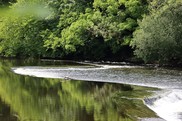
You have received this newsletter because we believe you may have an interest in the new LIFE Dee River project. If you are happy to receive further newsletters from us, then you don’t have to do anything.
If you no longer wish to receive newsletters from us, you can unsubscribe at any time.
|
|
|
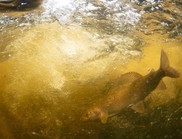
LIFE Dee River is an ambitious, multi-million pound river restoration project to transform the River Dee and its surroundings, to help improve declining fish populations and rare wildlife in the area. The £6.8 million, cross-border project will bring multiple benefits to the environment, particularly improving the numbers of salmon, lamprey and freshwater pearl mussels, helping them become more sustainable in the future.
The project was officially launched online in September 2020, with over 150 attendees, and included presentations and messages of support from Clare Pillman, NRW Chief Executive; Sir David Henshaw, NRW Chair; Hannah Blythyn MS, Deputy Minister for Housing and Local Government; Will Millard, Angling Author and TV Presenter, and Joel Rees-Jones, LIFE Dee River Project Manager.
Many thanks to everyone who joined us - we were overwhelmed with all the supportive feedback we received about the project. If you weren’t able to join us, you can watch a recording of the launch again here.
|
|
|
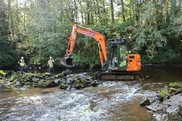
Only a couple of days after launching the project, we were put straight to work and successfully completed our first major milestone, a weir removal on the Afon Tryweryn, a tributary of the River Dee.
Work to dismantle the redundant weir on the Tryweryn was carried out by experienced local contractors, in conjunction with NRW’s technical specialists, to remove the man-made structure and help improve access for fish. Boulders from the weir were redistributed to provide important habitat and spawning areas for the variety of species that live in the river, and were also used to stabilise the river bed.
To celebrate World Fish Migration Day in October, we released a short film showcasing the weir removal to highlight the importance of barrier removal to migratory fish, and the wider benefits it can bring to the environment. Watch the film here.
|
|
|
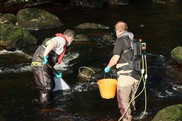
Assessing the impact of our interventions is vitally important to the project, not only to deliver a robust evidence base but also to ensure we adapt and make changes where required. Our first monitoring task was to carry out an electrofishing survey on the Tryweryn before the weir was removed, which we managed to complete in the short window of opportunity before the electric fishing season ended.
We also surveyed four sites at Morlas Brook – we didn’t find any juvenile salmon in the three sites surveyed upstream of the ford, however, we did find three salmon immediately below the ford. This highlights the potential impact of the structure to all fish species, particularly bullheads, and how even adult fish struggle to pass this barrier under normal flow conditions.
One key area of our monitoring will focus on sea and river lamprey range and movements both in the main stem and around our intervention sites. For this to be successful, we need samples of live adult lamprey to tag - unfortunately this hasn’t proven easy in the last five years on the Dee! Trials of a new mobile trap began in October (at the very beginning of the river lamprey run) and so far, we’ve trapped three early migrants plus plenty of other species including eels, chub and Chinese mitten crabs. It’s hoped that trials will be more successful as the lamprey runs gets into full swing. Watch this space...
|
|
|
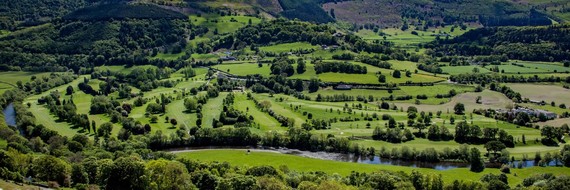 Image credit: Sean Thompson
The golf club situated in the scenic Dee valley has the 9th, 15th and 16th fairways adjacent to the River Dee. Concerned about possible bank erosion during flood events, the club asked us for some advice about tree planting to help protect the river bank.
Following a visit, it became clear that this initiative would be beneficial to both the club and the project. For the golf club, it would stabilise the bank and reduce the potential for bank erosion damaging the fairways. For the project, stabilising the bank would reduce eroded sediment entering the river (too much sediment impacts on river ecology) and provide additional habitat for birds and other wildlife. A number of sections along the fairways were identified that would benefit from additional trees, using a mix of native tree species suited to local riverine conditions and whose height at maturity would not excessively shade the fairways. Planting is expected to get underway early in the New Year.
|
|
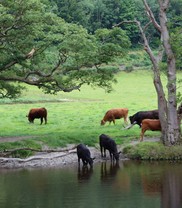
Over the past few months, our Land Management Officers have been carrying out pollution prevention visits, and identifying farms that would benefit from the 100% funding that is available towards preventing livestock access into the watercourses. Several other interventions will be carried out too, such as culverting watercourses to reduce the amount of sediment entering the Dee, as well as fencing and planting work over the winter.
The proposed works in the forestry blocks of Penaran, Aberhirnant and Llangower are also progressing. Over the next four years, up to 21 additional culverts will be installed to prevent flash flood water containing sediment and contaminates from the forestry track entering the natural water courses. Additionally, at Penaran, two bridges will be constructed on the main arterial forest road to replace the existing river crossings.
Please do get in touch with the Land Management Officers if you are interested in working with us. Ifor and Tom are more than happy to offer advice and support, and explore potential areas for works that would benefit both the land and the river. Email Ifor Potts or Tomos Wynne for further information.
|
|
|
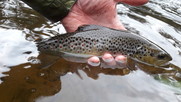
We are very excited to be offering schools all over the country an interactive opportunity to learn about brown trout this month, by live streaming fish eggs hatching!
Led by Snowdonia National Park Authority (SNPA), learners will get the chance to watch the trout develop from tiny eggs to fry (baby fish), filmed in real time through a live feed accessed via SNPA’s website. To enhance their experience, learners will receive a series of educational resources including a workbook to track the lifecycle of the fish and determine when they will need to be released into their natural habitat. Once they are large enough, the fish will be released into the River Dee to continue their lifecycle. The live video feed and educational resources are available now on SNPA’s website for schools and fish enthusiasts all over the country to enjoy.
|
|
|
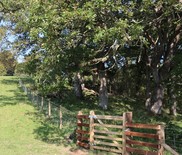
The project has had a very busy few months since starting, with plenty more work on the horizon. These are our plans for the next few months...
Approximately 2½km of fencing will be erected on several farms in the catchment to reduce the amount of nutrients and sediment being introduced into the Dee. Combined with the planting of several hundred trees, this will help to reduce livestock access to the river and therefore reduce sediment and nutrient introduction. Trees will also help stabilise the banks and shade the water where required, to keep temperatures lower during hot weather periods.
Outline designs for 6 structures, listed below, will be completed in early 2021 to allow discussions with landowners and interested parties to progress prior to confirming final designs and starting construction:
- Morlas brook
- Erbistock weir
- Llangollen upstream weir (above the bridge)
- Llangollen downstream weir (below the bridge)
- Chester weir
- Horseshoe Falls, Llangollen
|
|
|
|
|
|